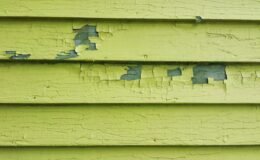Hot Weather Exterior Painting

Hot Weather Exterior Painting in the summer months can present some unique challenges for the property owner, the painters and the paint itself.
Hot weather, humidity and afternoon rains all affect the quality of the exterior painting. The majority of paints are latex or water-based. This may be a duh, but the primary ingredient is, you guessed it, water! Latex paints dry by the proper evaporation of water leaving behind the pigments and protective coating.
The ideal temperature for painting is 70-80 degrees with humidity around 50-60%. If we are lucky, that happens about 5-6 days a year in New England. Applying commonsense to “summer painting” will help minimize problems often associated with hot weather, since most latex finish paints can be safely applied between 35 and 100 degrees.
These are some of the issues of hot weather exterior painting
- Temperature for application is based on the surface temp not the air. A wall in the sun can be 10-25 degrees hotter than the air.
- Dry-rolling and lap marks may occur resulting in an uneven look on the building.
- Spray and back rolling is the best method for paint application. Rolling alone rarely results in getting the proper thickness of paint on the surface. Back rolling on a hot surface can pull off paint if not done correctly.
- Over wicking of paint on drywall porch lids is common. Tape seams can come loose and wallboard may even warp due to the extra moisture and weight.
- Rapid acceleration of the paint curing process may result in wrinkles and bubbles in the paint. Improper adhesion results in paint system failure.
- Afternoon thunderstorms can cause spotting or rain off paint onto other surfaces like patios, pool decks and walkways.
- Excessive dew and condensation (like our night fogs) can cause uneven sheen formation on the surface.
- Dehydration and heat stroke is a major concern for the painter. This is hard, hot and exhausting work.
- Ladders, tools and equipment can be slippery when wet from perspiration. Application accuracy goes down and the risk of injury goes up.
Solutions
- Hire a licensed / insured painting professional. Let them take the risk and make sure the paint job is completed correctly. (Our favorite of course!)
- Preparation of the surface is more important than the finish coat. It should take almost as much time as the painting. Shortcuts here can lead to disasters later.
- Inspect cracks and areas for caulking early in the morning. Complete your crack prep, caulk and seal during the times when the gaps are at their maximum. Make sure you use the correct products for each type of substrate.
- Use only high quality paints and materials like those from companies like Sherwin Williams or Benjamin Moore. These companies also provide you with expert advice.
- Always read the label and the MSDS for product-specific directions. If you have any doubts, call the manufacturer for specifics. Application mistakes and errors are not warranted by the paint companies.
- Most of you will not attempt to use a sprayer. Even larger professional crews, there is normally only one or two people that spray. There is both art and science to spraying. You need the right tips and a lot of talent. If you do attempt this, make sure you have enough Crude Cutter around to clean up the mess.
- Use heavy duty brushes and rollers that hold a lot of paint. Professionals typically use 4” high quality brushes and thick nap rollers. Most Homeowners either do not invest in quality tools or feel comfortable working with them. They are heavy and bulky when loaded with paint.
- It may take 3-5 different sizes of ladders to paint your property. You may own one or two. Go rent the proper size ladders and make sure you understand the physics of where and how to use them correctly. Improper ladder use is a major safety concern.
- You may need to climb on the roof to reach areas of the building. Roofing is very hot in the sun and minor burns can result from contact. Also make sure you do not damage hot shingles or crack tiles.
- Getting to areas above pool screens is very difficult. If you remove screening, in most cases you will need to replace it with new materials. Professionals often know how to work over top of the cage without screen removal. I recommend you do not attempt this on your own. Very delicate and extremely hazardous if not done correctly.
- You must keep a “wet edge” and surface at all times. This means a lot of paint on the tools and working fast. You must avoid lap marks and or actually pulling paint back off the surface.
- Avoid rushing to put on a second coat of paint. Double the dry time in hot humid weather before second coat application.
- Always “pot” your paint and make sure it is completely mixed. Colors can vary from one can to the next. Use another bucket to mix gallons (like a 5 gallon bucket). Be mindful of the paint in your bucket as the top layer can cure. You make need to strain the paint to remove this stuff.
- Buy a laser temperature measurement tool and monitor surface temps throughout the job. Stop working if temperatures exceed the limits.
- Avoid painting and staining when humidity is extremely high or right after a heavy rainstorm.
- Work or move around the house to avoid the sun as much as possible. Shade is good if you can find some.
- Allow sufficient time for the coating to dry (approximately 1.5- 2 hours) before sunset. Helps eliminate “dew striking” a new film and creating an uneven sheen. Painting for a couple of hours when you get home from work is not a good idea.
- Keep an eye on the weather radar. Again, it’s best to have at least 1.5 – 2 hours before the rain hits. Heavy downpours can ruin paint many hours after application.
- Hydrate and rehydrate. Drink lots of water and maybe some Gatorade. You will sweat out a ton and the risk of heat stroke is ever present. This is not like sitting at your computer in the office. It’s hard, hot and physical. Don’t even think of attempting this if your health is poor.
- It is going to take longer than you think to paint your home or property. You planned to complete this on your weeks’ vacation? It could take you all summer. The longer the project runs, the less likely it will look great and the more frustrated you will become as it eats up your free time.
- Be careful. You are not likely used to working in the heat, climbing or moving ladders. Muscle strains, back injuries and serious damage from falling off ladders are more common than you might think. Your summer project could have lifetime effects.
We hope this helps if you decide to DIY. Painting in hot weather can be tricky and risky. Please take your time and do it right. If you decide to cherish your free time and enjoy the summer. You can leave the house or business painting to Amazing Painting Company. No hassles! No worries! We promise you’ll get integrity, value, and quality from the very best painting company in Massachusetts.
- Local Exterior Painters
Call us today 978-380-8700












